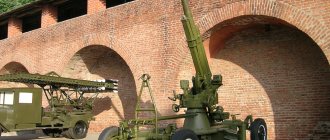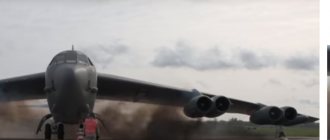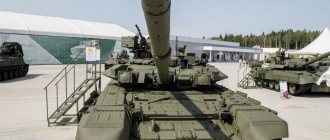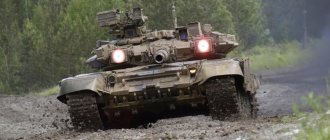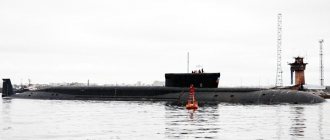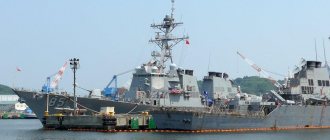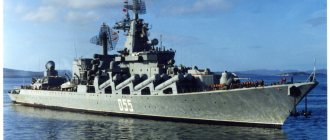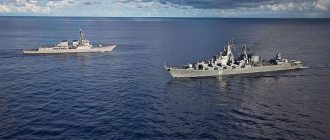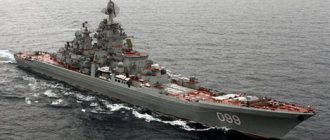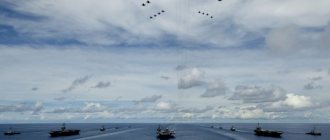Return of Russian corvettes
Marine collection No. 4 2004
A. Mozgovoy
Last year, the Severnaya Verf shipyard in St. Petersburg laid down the keel of the Soobrazitelny corvette, the second in the Project 20380 series. Why did Russia begin updating its fleet with the construction of ships of this class?
At first glance, only a specific English sense of humor, and even aggravated by the sad circumstances of the war, can explain why these awkward ships began to be called “corvettes.” They were not at all like the graceful and swift sailing and sail-steam corvettes of the 18th - 19th centuries, intended for reconnaissance, messenger and cruising service. But then the British had no time for humor. The economy of the island state was on its last legs due to the brutal blockade of Britain by German submarines. The losses of ships en route to Foggy Albion grew catastrophically. The introduction of the convoy system did not bring any significant improvement. There simply weren’t enough destroyers to guard them. And then the Smith's Dock company proposed to build escort ships based on the Southern Pride whaling ships. This is how the famous Flower-class corvettes appeared. Their displacement was about a thousand tons, and their speed in clear weather barely reached 17 knots. But they were distinguished by their simplicity of design and low cost, had good seaworthiness and could accept a fair amount of depth charges, that is, they were ideally suited for convoy service. Last but not least, thanks to the “flowers” and more advanced corvettes of subsequent series, Britain and its allies managed to win the Battle of the Atlantic. In other words, the “flowers” bore tangible fruit.
Sailing-steam corvettes “disappeared” from the Russian Imperial Navy in 1892, when some of them were written off due to disrepair, others were transferred to the training category, and only the Rynda corvette was reclassified, in modern terms, as a cruiser. However, at the dawn of the 21st century. Russia has a need for corvettes.
Among the reasons that caused the revival of this class of ships in the Russian Navy, perhaps the main one is similar to the one that led to the appearance of “flowers” in the British Navy during the Second World War. This reason is economic. In the 90s The last century saw not only the massive decommissioning of warships of the main classes of the once powerful Soviet Navy, but also the physical and moral aging of those remaining in service. It is obvious that at present, due to the insufficiency of the defense budget, Russia cannot yet afford to build cruisers, destroyers, and ocean patrol ships (frigates) for its Navy in any large series. In addition, not only in Russia, but throughout the world, there is a rethinking of views on the nature and methods of conducting combat operations at sea. And these views have not yet been established. Therefore, the construction of expensive large warships can be postponed. But the need for relatively cheap corvettes is acute.
Actually, the ships of Project 20380, which include the Steregushchy and Soobrazitelny being built in St. Petersburg, are called corvettes only in everyday life. According to the current official classification, they are “multi-purpose patrol ships of the near sea zone.” However, it would be wrong to talk about the new Russian corvettes only as “patrol ships”, since the very line of development of this class in the domestic Navy is distinctive.
The Uragan-class patrol boats (Project 2) - by the way, the first large surface ships built for the Red Fleet after the Civil War and the period of devastation - did not at all resemble escort or patrol ships. In fact, they were torpedoboats, designed for joint operations with Novik-class destroyers in the “closed” Baltic and Black Seas. The Yastreb type (Project 29) TFRs that followed the Uragans, laid down before the start of the Second World War and put into operation after its end, were a continuation of the destroyer line. In the 1950s patrol boats of the "Falcon" type were built (project 42). In terms of displacement, armament, and speed, they were closer to the destroyers of the beginning of World War II than to classic patrol and escort ships.
A landmark ship for the Soviet Navy was the Ermine-class patrol ship (project 50). “Fifties,” as the sailors called them, looked similar to “falcons”, but had a smaller displacement (1200 tons versus 1600) with the same speed and almost the same armament.
They had three universal 100-mm artillery mounts, two twin 37-mm anti-aircraft guns, torpedo tubes, depth charges, conventional and rocket launchers, and could take up to 26 minutes. Technological and cheap “fifty dollars” were built in a large peacetime series of 68 units. Anti-submarine operations and combat against surface enemies, protection of communications and water areas adjacent to ports and naval bases, laying minefields and artillery support for amphibious landings - this is not a complete list of tasks that these “workhorses” of the fleet solved during the exercises. And not only Soviet.
"Fifty dollars" were part of the navies of Bulgaria, the GDR, Indonesia and Finland. In China, the TFRs of this project were built under license and, instead of torpedo tubes, they were equipped with launchers of Hai Ying 2 anti-ship missiles.
In the early 1960s. In the Soviet fleet, highly specialized patrol ships of Project 159 (“Petya”) - according to NATO classification) and then Project 35, designed for anti-submarine defense, also appeared. They were united with classic foreign corvettes by both their tasks and displacement - about 1000 tons - and were distinguished by their speed - more than 30 knots. The same high-speed corvettes include small anti-submarine ships of the Albatross type of Project 1124. With a displacement of just under a thousand tons, they have, compared to the SKR Projects 159 and 35, even more effective air defense weapons - the Osa-M anti-aircraft missile system.
Most of these ships have served their purpose long ago. By the beginning of the 1990s. “fifty kopecks” were written off, followed by SKR projects 159 and 35. The number of “albatrosses” decreased significantly. In addition, the latter cannot in any way be classified as multi-purpose ships, since they do not have strike missiles and artillery weapons. If we call everything by its proper name, then after the last fifty-kopeck piece was scrapped, the Russian fleet was left without universal combat ships in the near sea zone.
But it is precisely the fact that Project 20380 corvettes belong to the ships of the near sea zone that most of all arouses the anger of opponents of the implementation of their construction program. They say that Russia first of all needs an ocean-going fleet. Who would argue? But, as already noted, the country does not yet have the economic conditions for the revival of a full-fledged ocean-going fleet. What tasks are the few warships in the ocean zone of the Russian fleet engaged in today? Mainly protecting the positions of strategic nuclear submarine cruisers and ensuring access to the ocean for multi-purpose nuclear submarines. Agree: it’s not a royal matter when the heavy nuclear-powered missile cruiser “Peter the Great” plays a role that a modest patrol ship could handle with equal success.
Opponents of Project 20380 also claim that the Steregushchiy-class corvettes are “an ordinary European frigate of the 1980s.” with weak strike potential and low combat stability, since their air defense systems are insufficient. Let's try to understand these arguments.
The very fact that critics of the corvette “pull it up” to a frigate testifies to the extraordinary qualities of the ship. The total displacement of the Steregushchy is 2100 tons and, indeed, is approaching that of a frigate. The Uran anti-ship missile system is no worse than the American Harpoon or the French Exocet, which form the basis of the strike weapons of modern foreign frigates and corvettes. But the universal automatic 100-mm artillery mount AK-190 with the Puma fire control system is significantly superior to the 76-mm OTO-Breda artillery mount, used as the main caliber on most similar Western-built ships.
But it’s better to continue the topic by comparing the Steregushchy with the K-130 type corvettes being built for the German Navy. This is also a universal ship with a displacement of 1650 tons. And the range of its weapons is close to that of Project 20380.
Initially, the K-130 was planned to be armed with promising stealthy NSM anti-ship missiles from the Norwegian company Kongsberg. However, it soon became clear that fine-tuning the NSU would take a lot of time and this missile would not be in time for the commissioning of the lead K-130. Then they decided to install American Nagroop anti-ship missiles on the corvette. But in the end, it seems, they chose the Swedish anti-ship missile Saab RBS - 15 Mk-3.
It is not yet clear whether the arsenal of the first ships of the K-130 type will include short-range Polyphem-S missiles, controlled via a fiber optic-guided missile and designed to hit ground targets at a distance of up to 60 kilometers. German designers encountered difficulties when creating this weapon. The new unmanned helicopter, designed to perform reconnaissance functions on a corvette and serve for target designation of anti-ship missile systems, is still far from being ready.
TsMKB Almaz, the developer of Project 20380, has sad experience of creating ships with weapons systems that are not yet up to standard. The Novik frigate, laid down in 1997 and at one time widely advertised, has not yet been completed. The delay was influenced not only by unsatisfactory funding for the construction of the ship itself, but also by the lack of ready-made weapons systems for it, which, at best, did not leave the testing stage.
That’s why the designers of corvette 20380 decided not to take risks and installed the well-developed Uran anti-ship complex on it. As an air defense weapon, one combat module of the Kortik/Kashtan anti-aircraft missile and artillery complex with ammunition for 64 missiles and two automatic 30-mm six-barreled AK-530M installations will be used. By the way, on the K-130, two installations of the RAM 21 short-range air defense missile system are unlikely to provide better defense for this corvette than the Dirk for the AK-630M Steregushchy. But in terms of aviation capabilities, our ship looks clearly preferable. The Ka-27 helicopter is capable of performing a wider range of tasks compared to even the most advanced ship-based drone: conducting reconnaissance and patrolling, carrying out target designation, and participating in rescue operations. And, of course, it is indispensable for anti-submarine warfare, the importance of which has recently been underestimated in the West. And the Steregushchy’s anti-submarine weapons are very convincing. From two twin-tube torpedo tubes, the ship is capable of attacking an underwater enemy with 16 torpedoes or missiles of the Vodopad complex. The Project 20380 corvette has developed hydroacoustic means - sonar with an underwing antenna and with a towed one.
The designers also took care of strengthening the ship's armament in the future. The corvette has reserved volumes and energy capacities to accommodate modules of universal vertical launchers of Onyx/Yakhont anti-ship missiles, anti-aircraft missiles of the Poliment complex and Medvedka anti-submarine missiles. The export version of the corvette (project 20382) involves the placement, at the customer’s request, of not only Russian weapons systems, but also weapons of foreign production.
On Steregushchy, the main power plant is diesel, which will allow it to reach speeds of up to 28 knots. But the power plant can also be diesel-gas turbine (CODOG), and then the full speed will be more than 30 knots.
The designers spent serious efforts on carefully developing the ship's elements. As a result of lengthy research, experiments and tests at the Central Research Institute named after. Academician A.N. Krylov managed to give the body a shape that significantly reduced the resistance to movement. Particular attention is paid to reducing visibility and increasing survivability. Stealth technologies will be widely used on the ship. The sides of the hull and the walls of the superstructures are made of sandwich composites with a radio-absorbing coating and are inclined to the center plane, which will reduce radar reflection. The set of measures will also make it possible to reduce acoustic, infrared and magnetic signature. So, to reduce noise, shock-absorbing platforms are used, on which engines are placed in one package with gearboxes, diesel generators are “suspended” to the second deck.
The electronic filling of the ship is based on the new element base. A variety of command and combat post facilities are integrated into a single automated system that allows one to assess the situation and make decisions in real time. The introduction of widespread automation led to a reduction in crew size to 100 people. (there were 168 of them on the “fifty kopecks”), which means an improvement in habitability, that is, an increase in the quality of life of personnel. Therefore, talking about Project 20380 corvettes derogatorily, as “ordinary” ships, is at least tactless.
Without their construction and development, it is unlikely that new modern frigates, cruisers and aircraft carriers will appear in the Russian fleet.
References to the fact that only small fleets are replenished with corvettes are also unfounded. Currently, a competition is being held among American companies for the best design of the so-called “littoral combat ship” (LCS), designed to fight enemy warships and submarines in the coastal sea zone of states that, for one reason or another, the United States intends to “ punish". In terms of their characteristics, “littoral warships” are close to corvettes: the same displacement, range of weapons and stealth technologies.
The very American doctrine of using fleets off foreign shores initiates the development in other countries of means capable of restraining US intentions. And among these means, not the last place is occupied by corvettes, capable of carrying strike and defensive weapons, and at the same time not very expensive.
Taking into account the current situation, Russian design bureaus offer customers a wide range of corvette-class ships. Thus, according to the project of the Zelenodolsk Design Bureau, corvettes of the “Gepard” type (project 11661) are being built. The first of them, “Tatarstan,” was transferred to the Caspian Flotilla of the Russian Navy in 2002. In accordance with the requirements of the theater, it is armed primarily with missiles (Uran anti-ship missiles) and artillery systems (one 76-mm AK-176 universal cannon and two AK-630M assault rifles ). But the composition of the cheetahs’ weapons may be different. The Zelenodolsk Design Bureau has developed several options for equipping these corvettes with strike, anti-submarine and anti-aircraft weapons, depending on customer requirements.
The projects of two corvettes were created by the St. Petersburg Northern Design Bureau. The S-1800 type corvette with a displacement of 1,800 tons is designed to combat enemy surface ships and submarines, repel air attacks, protect ships during sea passage, and control the maritime economic zone and territorial waters. Its main weapon is the Club-N universal missile system with anti-ship and anti-submarine missiles in vertical launchers. For the first time, medium-range Shtil air defense systems are being deployed in the same below-deck installations. A 100-mm AK-190 artillery mount and two AK-630M assault rifles are designed for firing at surface, coastal and air targets. Anti-submarine weapons are reinforced with 400-mm torpedo tubes and a helicopter. The corvette is supposed to use diesel engines powered by two fixed-pitch propellers as propulsion engines. The gas turbine unit will provide a forced speed of 27 knots. The corvette's cruising range is 3,500 miles.
The younger brother of this ship with a displacement of 1350 tons has approximately the same specialization. But instead of the Shtil air defense system and AK-630M assault rifles, it will have two modules of the Kashtan missile and artillery complex. And its full speed will increase to 30 knots. The cruising range will also increase to 4,000 miles.
Both corvettes of the Northern Design Bureau will have low visibility due to the introduction of various elements of stealth technologies. That is, they meet the most modern requirements.
The passion for corvettes has not bypassed the leading Russian research organization in the field of shipbuilding - the Central Research Institute named after. Academician A.N. Krylov. In addition to the orders from the Northern Design Bureau, the Almaz Central Marine Design Bureau and the Zelenodolsk Design Bureau for certain areas of work on the corvettes of these design bureaus at the Central Research Institute named after. Academician A.N. Krylov created a whole family of his own designs for corvettes with a displacement of 1000 to 2000 tons. The “know-how” of these ships is a fundamentally new hull form. It allows you to reduce water resistance to movement at a speed of 30 knots. by approximately 25%. This makes it possible to use a less powerful, and therefore lighter, power plant. By lightening the power plant, reserve volumes are created on ships to accommodate weapons. Thus, on the corvette of variant XXI - with a displacement of 2000 tons, along with anti-ship and anti-submarine missiles of the Club-N or Yakhont complex, 16 Rif-M long-range air defense missiles are placed in vertical launchers, that is, the corvette is capable of participating in providing zonal air defense and missile defense connections of ships. All variants of corvettes provide for the implementation of the latest achievements of stealth technologies, which reduce the average effective dispersion surface in a circle by almost three times, and therefore the probability of targeting ships with anti-ship missiles is reduced from 0.5 to 0.1.
As we can see, the return of Russian corvette-class ships looks promising. In a number of tactical and technical characteristics and weapons, they are superior to foreign analogues, including promising ones. We can only hope that the developments of domestic designers will be appreciated by consumers.
Start
The keel of the corvette “Perfect” was carried out in 2006. However, in 2013, due to the price increase from the plant to 7 billion rubles, it was decided to suspend construction. The construction of the corvette "Perfect" was turned into a long-term construction project. Simultaneously with this ship, work was carried out on another vessel of this project called “Gromky”. In 2014, the Ministry of Defense signed a new agreement with the United Shipbuilding Corporation, under which the cost of two Project 20380 corvettes was 13 billion rubles. Production was carried out at the ASZ in the city of Komsomolsk-on-Amur (Khabarovsk Territory).
Fire control
The corvette is equipped with a fire control system (FCS) “Puma-02”. With its help, radio-technical weapons can simultaneously track four targets, two of which stand out as the most dangerous. Then the shooter selects the place where the projectile should hit and the fire mode. It can be either single or serial. In order to fire a large number of shells at an enemy ship, the shooter on the “Perfect” needs to press the pedal and hold it in that position for some time.
What ensures ship navigation?
Control over the firing and launch of missiles is carried out at the radio-technical weapons (RTV) combat post. This post is equipped with liquid crystal monitors on which targets are displayed. To facilitate shooting adjustments, RTV uses an optical tracking channel. As a result, enemy targets are shown on screens as real video images. The ship is equipped with a multifunctional television complex MTK-201. The system picks up a signal at a distance of up to 45 km. The guard only needs to capture a target on the screen, data about which is immediately automatically sent to the racks of the weapon systems. Aiming of guns is also carried out using automation.
For the corvette, they developed the Sigma combat information and control system, which is the software and operating system of the Perfect. It is connected to other ships, shore points and aircraft. Information about targets is received and processed here. Using signals emanating from an enemy ship, the commander of the Perfect can determine which state the ship belongs to. With the help of signals, side numbers, classes and even names of ships can be easily established. After all information about the enemy has been collected, MTK selects the most effective means to destroy it.
The corvette commander can detect enemy targets in the air using the Fourke-2 radar system. This radar is capable of detecting threats at a distance of up to 110 km. As a result, the ship's crew is reliably protected from air strikes.
Commissioning
In March of this year, the first sea trials of the “Perfect” corvette were successfully carried out. The naval ranges of the Pacific Fleet became the venue for artillery firing. The combat weapons of the Sovershenny corvette were tested in the early summer of 2017. State tests consisted of missile firing from the main ship's Uran missile system. A naval ship shield was used as a target. In addition, a target cruise missile was fired from the Russian boat "R-79", which the corvette successfully hit using the 100-mm A-190 gun mount. In July 2017, state sea trials were successfully completed. The corvette “Sovershenny” entered service with the Russian Navy on July 23, 2020.
Housing design
“Perfect” is equipped with a smooth-deck steel hull. The ASZ employees completed a high-quality outline of its underwater part. Thanks to this, it was possible to reduce water resistance to 25%. The lower part of the vessel below the waterline is of a convex ellipsoidal shape. In shipbuilding, such a design is called a “bow bulb”. Thanks to it, the flow of water is systematically distributed along the entire hull of the corvette, which saves fuel and also increases speed and cruising range.
Construction and release of the ship
The Project 20380 corvette “Perfect” was developed by employees of the central design bureau of St. Petersburg. In April 2014, ASZ entered into a state contract with the Tula Machine-Building Plant for the production of two AK-630M-06 artillery mounts for the Sovershenny corvette.
In May 2020, the ship was launched. In November 2020, mooring tests and demagnetization were carried out on the corvette. In January 2017, factory sea trials were carried out, after which the ship went to sea.
Purpose
The uniqueness of both Project 20380 corvettes is that these ships can be upgraded if necessary. Advanced corvettes are capable, in addition to their patrol missions, of detecting enemy submarines, surface targets, fighters, cruise missiles and torpedoes with their further destruction. In addition, it is planned to use the “Perfect” to provide powerful fire support by delivering missile and artillery strikes during Russian landings.
GEM
The Corvette is equipped with a two-shaft main diesel power plant. It is based on two DDA 12000 diesel units. One such unit contains:
- Diesels 16D49 (two pieces), which are manufactured at the Kolomensky plant.
- Two reduction gears.
- One summing reverse gear unit manufactured at JSC Zvezda.
Energy is generated by four diesel generators 22-26DG. The power of one generator is 630 kW.
